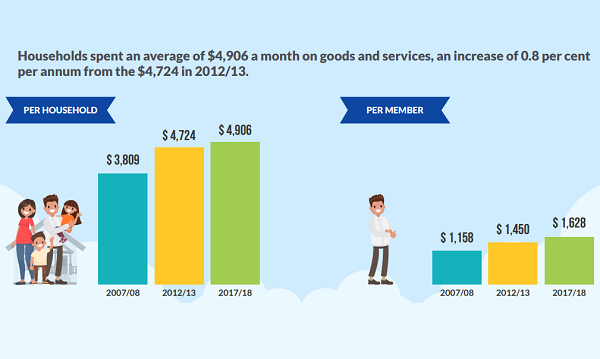
Household incomes up 2.4% to $11,780 in 2017-2018
An average of $4,910 a month is spent on goods and services.
In 2017-2018, Singapore resident households’ average monthly income from all sources rose 2.4% per annum in nominal terms (or 2.2% per annum in real terms) to $11,780 from $10,470 in 2012-2013, the Department of Statistics revealed.
According to the Household Expenditure Survey, households spent an average of $4,910 a month on goods and services, an increase of 0.8% per annum from the $4,720 in 2012-2013. Household income rose faster than household expenditure on an overall and per household member basis over the five-year period.
The average monthly income of households increased by 1.6% per annum in nominal terms (or 1.5% in real terms) for the top 20% income group, and by 2.7 to 3.3% per annum in nominal terms (or 2.4 to 3% in real terms) for the other income groups. By housing types, households living in HDB 1- and 2-room flats experienced the highest income growth, at 6.3% per annum in nominal terms, or 6.1% in real terms.
In terms of expenditure, the average monthly expenditure of households in the top 20% income group remained relatively stable between 2012-2013 and 2017-2018. On the other hand, the average monthly expenditure rose by 0.4 to 3% per annum for households in the other income groups.
By housing types, average monthly expenditure remained generally stable for households staying in HDB 4-room flats, condominiums and other apartments, and landed properties. By comparison, the monthly expenditure of households staying in HDB 1- and 2-room, 3-room, and 5-room and executive flats increased by 0.8 to 3.7% per annum. “Across income groups and housing types, income growth generally outpaced expenditure growth,” SingStat said.
Household expenses
Housing, food and transport accounted for the largest shares of monthly household expenditure and contributed to 62% of monthly household expenditure, slightly lower than the 65% recorded in 2012-2013.

SingStat found that food serving services accounted for 68% of their expenditure on food in 2017-2018, higher than the 64% in 2012-2013. On average, households spent $810 a month on food serving services in 2017-2018, up from $760 per month in 2012-2013, mainly due to increased spending in restaurants, cafes and pubs.
“Nevertheless, meals at hawker centres and food courts continued to constitute the largest share of expenses on food serving services,” SingStat added.
Average monthly expenditure on transport declined from $810 to $780 between 2012-2013 and 2017-2018, mainly due to a fall in spending on private road transport from $580 in 2012-2013 to $510 in 2017-2018. Average expenditure on bus and MRT/LRT fares also decreased by an average of $6 between 2012-2013 and 2017-2018, whilst average expenditure on taxi and private hire car services rose by $10.
Online expenditure increased with the growth of e-commerce, the report noted. In 2017-2018, about 60% of households reported online purchases, up from 31% in 2012-2013. The share of online expenditure also rose from 1.7% in 2012-2013 to 5% in 2017-2018.
Meanwhile, the home ownership rate amongst resident households remained high, at 89% in 2017-2018. Amongst the lowest 20% households by income, 85% were home owners in 2017-2018, up from 82% in 2012-2013.

The ownership of consumer durables such as television sets, washing machines and mobile phones was near universal at between 96 and 98% in 2017-2018 amongst all households, including those in the lower income groups and smaller HDB flat types. At the same time, households in the lowest 20% income group and HDB 1- and 2-room flats saw significant increases in their ownership of air-conditioners, as well as their access to Internet.
For households living in HDB 1- and 2-room flats, 25% owned an air-conditioner in 2017-2018, up from the 14% in 2012-2013, whilst 45% had an Internet subscription in 2017-2018, doubling from the 22% in 2012-2013.
On the other hand, the ownership of items such as residential telephone lines, digital cameras and Pay TV generally fell for households in most income groups and housing types, possibly due to the availability of substitutes such as mobile/smart phones and online video streaming platforms. Car ownership also declined, likely because of the increased availability of transportation alternatives, SingStat said.
























 Advertise
Advertise










